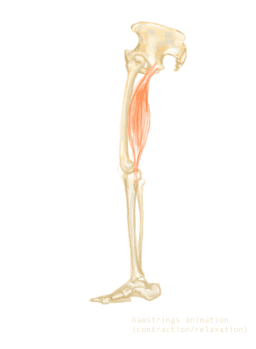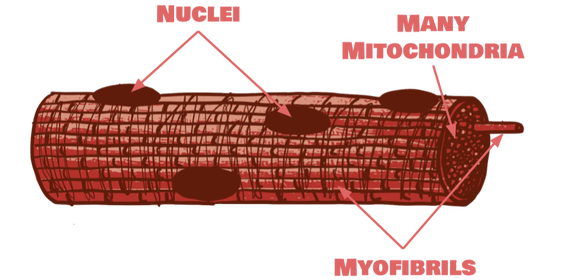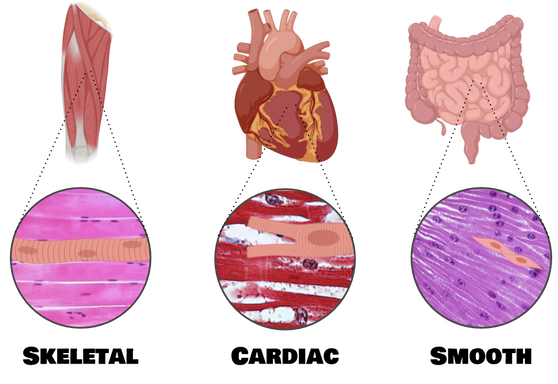the muscular system
We’ve just learned that bones provide leverage for muscles to help you move. But, bones still wouldn’t do you much good in terms of movement if you didn’t have muscles. Muscles contract and relax to allow for movement.
muscle contraction
When a muscle contracts, it gets shorter. It will look like it's bulging, and it is able to bear weight. This is because all the stuff the muscle is made of is squishing together, like a bunch of friends moving closer to each other to take a picture, in order to cause the contraction. You don’t need to know exactly how this process works for this class, but here’s a video, if you’re interested:
The events that set off muscle contraction are related to ions crossing the membrane through facilitated diffusion. The proteins that ions flow through to get into the membrane are gated. These gates are opened when they receive a biochemical message from nerve cells. You don’t need to know any of these details for this class, but it is a good reminder that everything that happens in the body is related to biochemistry, including simple chemical processes that you already know about, like diffusion.
When you flex your arm, that’s contraction. When you go for a run, your leg muscles are repeatedly contracting and relaxing.
When you flex your arm, that’s contraction. When you go for a run, your leg muscles are repeatedly contracting and relaxing.
antagonistic pairing
The relaxed state describes a muscle at rest, ready to contract when needed. In this state, the muscle is longer and not bulged.
Contraction: Bulging and getting shorter.
Relaxation: The long, at-rest muscle.
CC Wikipedia
Relaxation: The long, at-rest muscle.
CC Wikipedia
Relaxation is different from stretching a muscle, which is actively pulling the stuff the muscle is made of apart. Your muscles will not stretch on their own: you have to put force on them by something else, like another muscle, in order to pull them apart. So, then, how do we ever get a muscle to “uncontract,” if this would require pulling the fibers apart?
The answer is relatively simple: Muscles are found in antagonistic pairs, which means that each muscle will have a counterpart that does the opposite (“antagonistic” means fighting against). Your bicep bends your elbow up. Your tricep pulls your elbow back down. Your hamstring bends your knee back. Your quadricep pulls your knee forward again. Every muscle has its opposite. This video demonstrates:
The answer is relatively simple: Muscles are found in antagonistic pairs, which means that each muscle will have a counterpart that does the opposite (“antagonistic” means fighting against). Your bicep bends your elbow up. Your tricep pulls your elbow back down. Your hamstring bends your knee back. Your quadricep pulls your knee forward again. Every muscle has its opposite. This video demonstrates:
muscle structure
Muscles are made up of muscle fibers, or muscle cells, which are long and stringy. They are made up of long, stringy proteins. These proteins slide past each other to cause a muscle contraction when they get the go-ahead from nerves. Another unique feature of muscle cells is that they usually have a lot of mitochondria. This is because contracting muscles takes a lot of energy, so muscle cells need a lot of mitochondria to provide that energy.
Muscle fibers look a bit different from “regular” cells because they have a special function (to contract), so they need a special structure. And:
Muscle fibers are bundled together in bunches called fascicles, which are bundled together to make a whole skeletal muscle (such as a bicep).
attaching to bone
As we’ve learned, muscles are all but useless without their attachment to bones, which provide leverage. Tendons attach the muscle to the bone. They’re pretty stretchy, kind of like a rubber band. This allows the muscle to stay attached to bone (so that they can get that leverage for movement), while still having flexibility for range of motion.
If you’d like to learn more about tendons and what happens when they get damaged (usually due to athletic injury), this video gives a good overview:
If you’d like to learn more about tendons and what happens when they get damaged (usually due to athletic injury), this video gives a good overview:
skeletal, cardiac, and smooth muscle
So far, we’ve only been talking out skeletal muscle, which is the type of muscle that allows for voluntary movement of the skeleton. Voluntary means that we choose to move them, rather than it being an automatic body function.
There are also two other types of muscle in your body. Smooth muscle lines a lot of your internal organs and helps to move stuff along. For example, in the stomach and gut, smooth muscle contracts to push food through your intestines so you can digest it. Cardiac muscle is found only in the heart and helps to keep it beating. Both smooth and cardiac muscle are involuntary. That means you can’t consciously control how and when they work. Like skeletal muscle, smooth muscle and cardiac muscle both have unique structures that relate to their unique functions, but we won’t worry too much about the details of these cell types right now. The main focus here is on skeletal muscle.
There are also two other types of muscle in your body. Smooth muscle lines a lot of your internal organs and helps to move stuff along. For example, in the stomach and gut, smooth muscle contracts to push food through your intestines so you can digest it. Cardiac muscle is found only in the heart and helps to keep it beating. Both smooth and cardiac muscle are involuntary. That means you can’t consciously control how and when they work. Like skeletal muscle, smooth muscle and cardiac muscle both have unique structures that relate to their unique functions, but we won’t worry too much about the details of these cell types right now. The main focus here is on skeletal muscle.
Summary
This video gives a pretty good overview of the most important ideas we discussed in this lesson, plus offers you some useful tips for getting that superhero strength (spoiler: It involves using your muscles, regularly and often):
If you’d like a deeper dive into some of the scientific ideas we’ve discussed here, this video gives a good overview:
You should understand:
- That muscles contract when the protein filaments that make them up slide past each other, shortening the muscle.
- The difference between contraction and relaxation of a muscle.
- That muscles come in antagonistic pairs, like biceps and triceps, or quadriceps and hamstrings: when one contracts, the other relaxes.
- That muscles are attached to bones by tendons.
- That there are three muscle types: skeletal, cardiac, and smooth. You should understand which of these is voluntary and where each can be found.
Learning Activity
Contributors: Megha Kori, Emma Moulton
Some images made using biorender.com
Some images made using biorender.com






